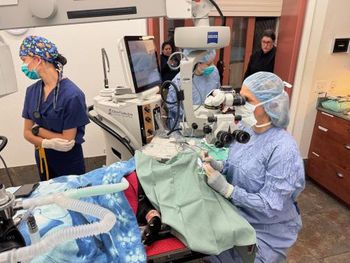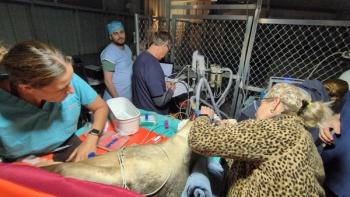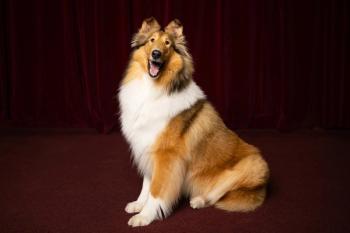
A new way of looking at glaucoma
Elevated intraocular pressure is now considered a risk factor for developing this common ocular disease, not the means of diagnosis.
Glaucoma is a complicated and often frustrating cause of vision loss in small animals. The pathogenesis of glaucoma is only partially understood, but the end result is loss of retinal ganglion cell function, axonal destruction in the optic nerve and vision loss.
Because clinical signs of glaucoma have been described in people without overt increases in intraocular pressure (IOP), and because optic nerve microcirculation and retinal ganglion cell function impairment have been observed before elevations in IOP in beagles with hereditary glaucoma, elevated IOP is now considered a risk factor for glaucoma, not the primary cause.1-4
Moreover, glaucoma is considered to be a group of many diseases, rather than one single disease, with a common outcome. In fact, in people, glaucoma is considered a neurodegenerative disease and a brain disease and is affected by alterations in systolic blood pressure and intracranial pressure.
Normal aqueous humor production-and when it goes awry
Normal aqueous humor dynamics involve aqueous humor production by the nonpigmented epithelial cells of the ciliary body via active transport, passive diffusion and ultrafiltration, with concurrent drainage from the globe through multiple mechanisms. In dogs and cats, most aqueous humor exits the eye through the iridocorneal angle and trabecular meshwork (conventional outflow), with a smaller volume exiting the globe through uveoscleral vasculature (unconventional outflow).
To maintain a stable IOP, the rate of drainage must match the rate of aqueous humor formation. Diurnal variations in IOP have been observed in most species studied, and, in dogs, IOP tends to decrease mildly with age.
Diagnostic evaluation
A normal IOP in any given patient depends on multiple variables, but IOPs in excess of 25 to 30 mm Hg in dogs and cats are generally concerning.
Accurate evaluation of IOP can be difficult because of patient noncompliance or other factors. Patient positioning, increased jugular pressure, the type of tonometer used, excessive eyelid manipulation during measurements, corneal thickness and cleanliness of the tonometer have all been identified as factors contributing to erroneous IOP estimation.2,5,6
To diagnose glaucoma, also perform a menace response, dazzle reflex and cotton ball test. A maze and obstacle course are also helpful, as well as determining whether the patient is goniodysgenic with gonioscopy.
Glaucoma as a primary disease
In dogs, glaucoma is most commonly diagnosed as a primary disease. Abnormalities in iridocorneal anatomy can be observed on biomicroscopic evaluation (gonioscopy). These visible abnormalities are considered to be linked to microscopic abnormalities in the conventional drainage system as a whole. Dogs with abnormally appearing iridocorneal angles (excessively narrow or closed) are considered goniodysgenic and are at risk of bilateral glaucoma in their lifetimes.
Primary glaucomas have been classified as either open angle or closed angle in both human and veterinary medicine. Open-angle glaucoma is most common in people, while in dogs most cases are closed angle. The difference is clinically significant since open-angle glaucomas are generally chronic, milder (increases in IOP of a few points are considered significant) and more responsive to medical therapy, while closed-angle glaucoma as observed in dogs is generally associated with an acute, marked increase in IOP that is accompanied by pain and acute vision loss.
The difference is also significant in that, because of availability of funding, most pharmacologic studies evaluating anti-glaucoma medications are based on the treatment of open-angle glaucomas. This includes veterinary studies, in which a rare colony of beagles with open-angle glaucoma are the target of most pharmacologic medical research.
In cats, a rare form of glaucoma known as feline aqueous humor misdirection syndrome (FAHMS) has been described in which changes in the anterior vitreous face result in aqueous humor accumulation in the vitreal chamber (rather than the anterior chamber), resulting in progressive anterior chamber shallowing and elevations in IOP.7
Most feline glaucomas, however, are secondary to chronic intraocular inflammation and can be especially difficult to treat given the dearth of effective anti-glaucoma medications in this species. Typically, uveitis leads to a secondary glaucoma in cats.
Glaucoma as a secondary disease
Common causes of secondary glaucoma include uveitis, intraocular hemorrhage, intraocular surgery, lens instability, retinal detachment and intraocular neoplasia. The pathogenesis of the secondary glaucomas usually involves either pre-iridal fibrovascular membrane (PIFM) development (in the cases of uveitis, intraocular hemorrhage, intraocular surgery, lens instability, retinal detachment and occasionally neoplasia), direct obstruction of the conventional outflow system (also in the case of lens instability and neoplasia), or both. PIFMs develop over the anterior or posterior surface of the iris and grow anteriorly to occlude the iridocorneal angle. To date, there is no known treatment available to prevent the development of these membranes in at-risk eyes.
References
1. Omodaka K, Horri, T, Takahashi S, et al. 3D evaluation of the lamina cribrosa with swept-source optical coherence tomography in normal tension glaucoma. PLoS One 2015;10(4):e0122347.
2. von Spiessen L, Karck J, Rohn K, et al. Clinical comparison of the TonoVet rebound tonometer and the Tono-Pen Vet applanation tonometer in dogs and cats with ocular disease: glaucoma or corneal pathology. Vet Ophthalmol 2015;18(1):20-27.
3. Bossuyt J, Vandekerckhove G, De Backer TL, et al. Vascular dysregulation in normal-tension glaucoma is not affected by structure and function of the microcirculation or macrocirculation at rest: a case-control study. Medicine 2015;94(2):e425.
4. Reinstein S, Rankin A, Allbaugh R. Canine glaucoma: pathophysiology and diagnosis. Compend Contin Educ Vet 2009;31(10)450-452.
5. Klein HE, Krohne SG, Moore GE, et al. Effect of eyelid manipulation and manual jugular compression on intraocular pressure measurement in dogs. J Am Vet Med Assoc 2011;238(10):1292-1295.
6. Slack JM, Stiles J, Moore GE. Comparison of a rebound tonometer with an applanation tonometer in dogs with glaucoma. Vet Rec 2012;171(15):373.
7. Czederpiltz JM, La Croix NC, van der Woerdt A, et al. Putative aqueous humor misdirection syndrome as a cause of glaucoma in cats: 32 cases (1997-2003). J Am Vet Med Assoc 2005;227(9):1434-1441.
Suggested reading
Plummer CE, Regnier A, Gelatt KN. The canine glaucomas. In: Gelatt, KN, ed. Veterinary ophthalmology. 5th ed., vol.2. Ames, Iowa: Wiley-Blackwell, 2013;1050-1145.
Dr. Micki Armour is a veterinary ophthalmologist with Eye Care for Animals in Leesburg, Virginia, and Frederick, Maryland.
Newsletter
From exam room tips to practice management insights, get trusted veterinary news delivered straight to your inbox—subscribe to dvm360.




